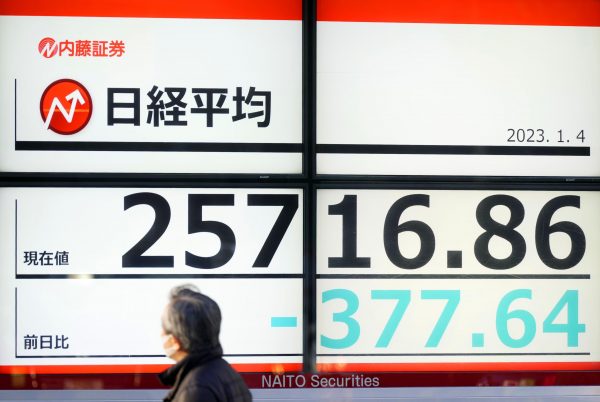The shock Japan has largely coped with is COVID-19. The pandemic itself is still ongoing. Its seventh wave that peaked in summer recorded the highest numbers of infections and deaths yet, and after a short lull, the eighth has started.
Still, the government refrained from announcing a state of emergency and restrictive measures throughout the year, minimising economic damage. This was primarily because vaccination has lessened COVID-19’s threat. People are still wearing masks, but their economic activity — shopping, eating out and sightseeing — is nearly back to normal.
Though the government lagged behind most countries in relaxing border controls, in September they were mostly removed. The removal substantially increased pent-up inbound tourism. This gives precious relief to many service industries that depend on foreigners’ growing interest in Japan as a tourism destination. Foreign workers are returning as well, which will ease serious labour shortages in some industries, including the recovering service sector.
This positive development has been overshadowed by new shocks. The Ukraine conflict’s direct impact on the Japanese economy has been minimal, because Japan’s economic relationship with Russia is rather small. Exports to and imports from Russia accounted for 1.0 per cent and 1.8 per cent of Japan’s total trade in 2021, respectively. But the war’s global ramifications — especially the sharp rise in commodity prices — hit Japan hard because of its dependence on imported fuel and food. Though global prices have come down, they left a visibly adverse impact on Japan’s balance of payments, inflation and the yen’s exchange rate.
As inflation surged in advanced economies, their central banks hiked interest rates. Inflation also picked up in Japan, increasing from 0.5 per cent in January 2022 to 3.8 per cent in November. This marked a 40-year high well above the Bank of Japan (BoJ)’s 2 per cent target. Yet unlike other central banks, the BoJ stuck to its loose monetary policy. The policy desynchronisation between home and abroad led to a sharp depreciation of the yen’s exchange value from around 115 yen per US$1 in January to 150 yen in October. A weaker yen helps some segments of the economy, but it is clear that the yen’s depreciation was the main driver of domestic inflation.
This caused uproar among the population that their real incomes were being substantially eroded. The government responded by intervening in the market in September and October with the first yen-buying operation in 24 years. The yen rebounded after the BoJ introduced a minor policy change in December, but the general perception that it is still weak due to the BoJ’s policy remains unchanged.
Inflation has come at last, after nine long years since the start of Quantitative and Qualitative Easing — a policy framework aimed at achieving 2 per cent inflation to battle deflation. Yet the BoJ is not rejoicing and normalising its policy. The BoJ justifies its inaction by citing stagnant nominal wage growth. Unless — and until — nominal wage begins to grow robustly, inflation well above the target may not be sustainable. In the meantime, the government has been busy implementing stop-gap anti-inflationary measures, such as cash handouts and gasoline and utility subsidies, as if countering inflation was fiscal policy’s responsibility.
Irregular policy surrounds the weak yen as well. In light of the widened interest rate differential weakening the yen, the most effective countermeasure would be a change in the BoJ’s monetary policy. But this was unequivocally denied by the BoJ, and instead, sizeable market intervention was undertaken by the government.
Against this backdrop, what is the needed policy mix going forward? While the BoJ may be right in saying it is premature to discard Quantitative and Qualitative Easing, there is room for modifying its fringes. The highly heterodox policy of ‘yield curve control’ (YCC) — that constrains government bond yields close to zero per cent for up to 10 years of maturity — can be removed, allowing the bond market to function better. The December policy change was a baby step in this direction, which resulted in a sizable rewinding of the yen’s depreciation. But the YCC policy is still kept intact.
Whether the BoJ can get rid of YCC smoothly is a different question. The bond market has been under strong pressure, which the BoJ has resisted ferociously through fixed rate purchase operations. Once the BoJ relaxes its brute-force suppression, interest rates might shoot up, which would immediately squeeze the government’s finances.
This would put the government in a very difficult position. But the silver lining is that the government would no longer be able to continue offering one fiscal painkiller after another to temporarily appease the public. The government would have no choice other than to squarely address the supply-side issues hindering sustainable growth — which is its most important task.
What to do is already laid out in the Grand Design and Action Plan for a New Form of Capitalism, published in June. The policy aims to create a mutually reinforcing dynamism between economic growth and more equitable income distribution. Japanese Prime Minister Kishida should use his waning political capital to progress this ‘New Capitalism’ campaign he initiated.
Masahiko Takeda is a Senior Fellow in the Australia-Japan Research Centre at Crawford School of Public Policy, the Australian National University.
This article is part of an EAF special feature series on 2022 in review and the year ahead.

